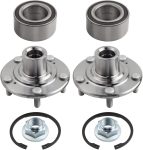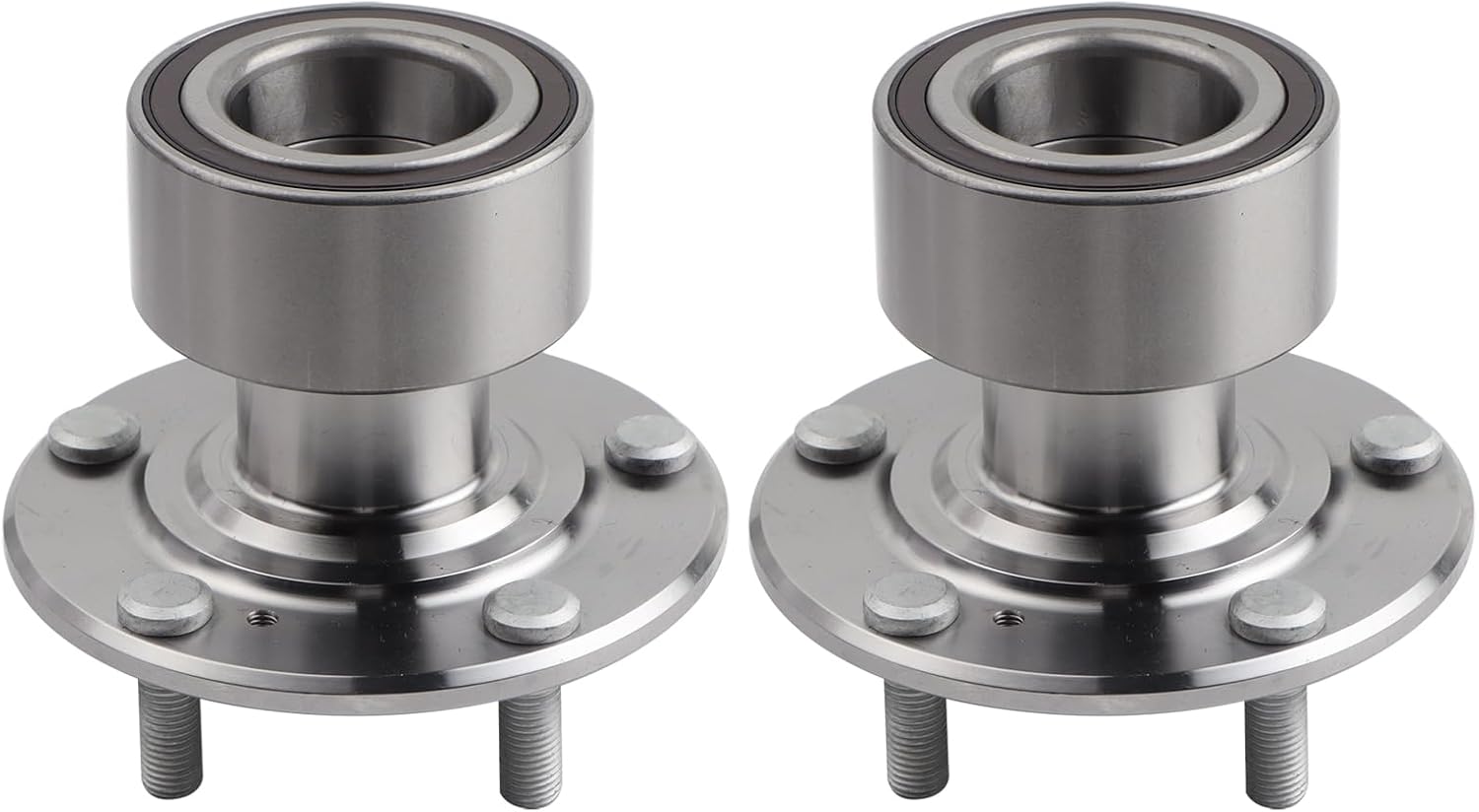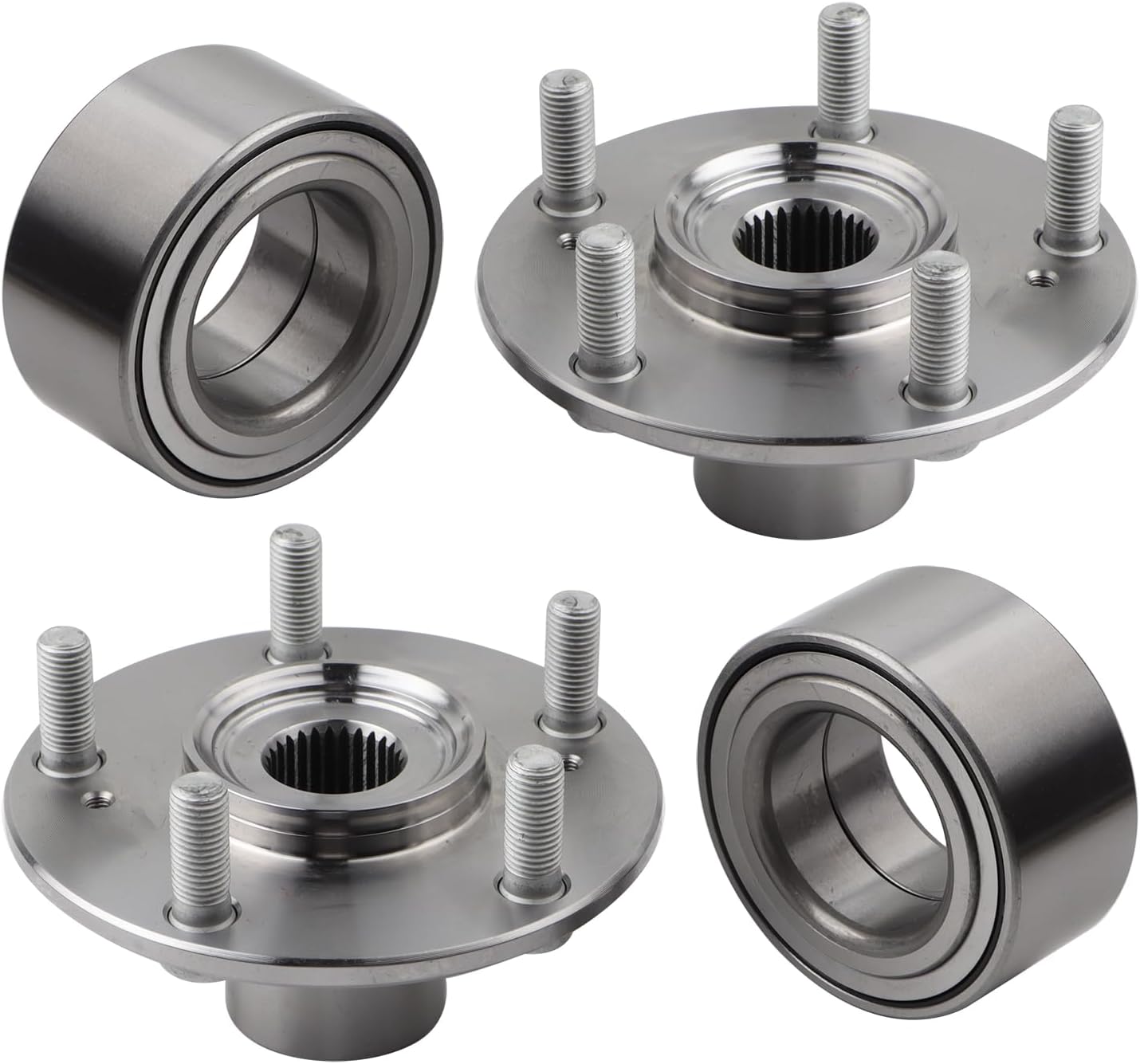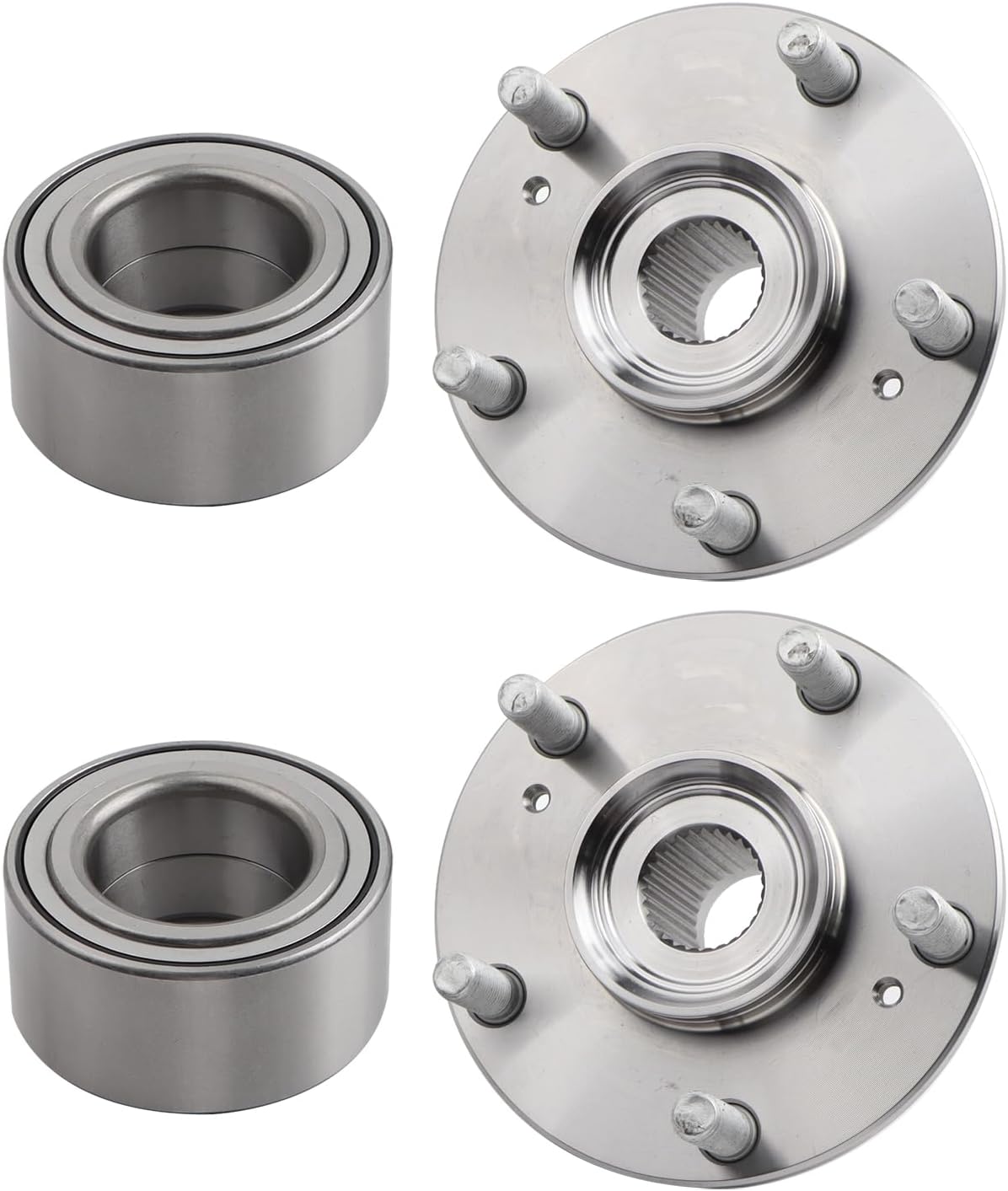
2 x Front Wheel Hub Bearing Assembly Review wheel bearing – Oemiu
2 x Front Wheel Hub Bearing Assembly Review: A Comprehensive Guide
The hum starts subtly, almost imperceptibly. At first, you might dismiss it as road noise, a quirk of the tires on the asphalt. But as the speed increases, the hum intensifies, morphing into a distinct drone that vibrates through the steering wheel and the floorboards. This, more often than not, is the telltale sign of a failing front wheel hub bearing assembly. Neglecting this sound can lead to serious safety concerns, and eventually, a complete wheel bearing failure, leaving you stranded on the side of the road. Replacing a worn wheel bearing is not just about silencing an irritating noise; it’s about ensuring the safety and reliability of your vehicle. This review delves deep into the world of front wheel hub bearing assemblies, focusing on what to look for, how to evaluate quality, and ultimately, making the right choice for your vehicle. We’ll also explore some common replacement procedures and what to expect during the repair.
Understanding the Importance of a Quality Wheel Bearing
The wheel bearing is a seemingly small, yet incredibly vital component in your vehicle’s suspension system. It’s the unsung hero that allows your wheels to rotate smoothly and efficiently. Located within the wheel hub, the wheel bearing assembly is responsible for connecting the wheel to the axle. It consists of precision-engineered bearings encased within a metal housing, designed to withstand immense loads and constant friction. A faulty wheel bearing not only affects the ride quality but also compromises the vehicle’s handling and braking performance. The increased friction can cause the bearing to overheat, potentially leading to catastrophic failure. This can result in a wheel locking up, making the vehicle uncontrollable, particularly at high speeds. Selecting a high-quality front wheel hub bearing assembly is paramount for safety and longevity. Considerations like the type of bearing (ball bearing or tapered roller bearing), the quality of the materials used in construction, and the precision of the manufacturing process all contribute to the overall performance and lifespan of the component. Saving a few dollars on a cheaper wheel bearing might seem appealing initially, but it often translates to premature failure, increased maintenance costs, and potentially dangerous situations down the road. Remember, your wheel bearings are critical for safe and efficient driving. Before installing your new front wheel hub bearing assembly, be sure to consult your car’s manual for any specific instructions or torque specifications.
The longevity of a quality wheel bearing is significantly influenced by several factors, including driving habits, road conditions, and proper maintenance. Aggressive driving, such as hard cornering and frequent braking, puts extra stress on the bearings, accelerating wear and tear. Similarly, driving on rough or uneven roads subjects the bearings to constant impacts and vibrations, shortening their lifespan. Regularly inspecting the wheel bearings for signs of wear, such as noise, vibration, or excessive play, is crucial for early detection of potential problems. Promptly addressing these issues can prevent further damage and potentially avoid a costly and dangerous wheel bearing failure. Many mechanics advise replacing the front wheel hub bearing assembly in pairs, even if only one side exhibits signs of failure. This ensures balanced handling and braking performance, preventing uneven wear on other suspension components. Moreover, it minimizes the likelihood of the other wheel bearing failing shortly after replacing the first one, saving time and labor costs in the long run. Properly torquing the wheel hub assembly during installation is essential for ensuring proper bearing preload and preventing premature failure. Using a torque wrench and adhering to the manufacturer’s specifications is crucial for achieving optimal performance and longevity.
Dissecting the Components of a Front Wheel Hub Bearing Assembly
A front wheel hub bearing assembly is not just a single, monolithic part; it’s a carefully engineered system comprising several key components working in harmony. The hub itself is the central component, typically made of forged steel for strength and durability. It provides the mounting surface for the wheel and incorporates the bearing races, which are the hardened surfaces that the bearings roll against. The bearings, whether ball bearings or tapered roller bearings, are the heart of the assembly, allowing the wheel to rotate smoothly and with minimal friction. Ball bearings are generally used in lighter-duty applications, while tapered roller bearings are preferred for heavier loads and higher performance vehicles. The bearing races are precision-machined to ensure smooth and even contact with the bearings, minimizing wear and maximizing lifespan. Seals play a crucial role in protecting the bearings from contaminants such as dirt, water, and debris. These seals are typically made of rubber or synthetic materials and are designed to create a tight barrier, preventing these harmful substances from entering the bearing assembly. Proper lubrication is essential for reducing friction and preventing wear within the bearing assembly. High-quality grease is used to coat the bearings and races, providing a protective film that minimizes metal-to-metal contact. The grease also helps to dissipate heat generated by friction, preventing overheating and extending the lifespan of the bearings. Some front wheel hub bearing assemblies also incorporate an ABS (Anti-lock Braking System) sensor. This sensor monitors the wheel speed and transmits this information to the vehicle’s ABS system, which helps prevent wheel lockup during braking. The ABS sensor is typically integrated into the hub assembly and is essential for maintaining proper ABS functionality.
The design and construction of each of these components significantly impact the overall performance and reliability of the wheel bearing assembly. Using high-quality materials, precision manufacturing techniques, and robust sealing methods are crucial for ensuring a long and trouble-free lifespan. Choosing a front wheel hub bearing assembly from a reputable manufacturer that adheres to strict quality control standards is essential for achieving optimal performance and safety. Consider the materials used in the hub’s construction, the type and quality of the bearings, and the effectiveness of the seals when making your selection. Also, check for any certifications or approvals that indicate the assembly meets industry standards for performance and durability. For example, some assemblies may be certified to meet specific load-bearing requirements or have undergone rigorous testing to ensure they can withstand harsh operating conditions. Furthermore, ensure that the assembly is compatible with your vehicle’s ABS system, if applicable. Incorrectly installed or incompatible ABS sensors can cause errors in the ABS system, potentially compromising braking performance. A properly functioning front wheel hub bearing assembly is essential for maintaining safe and predictable handling. By understanding the components and their functions, you can make an informed decision when replacing your old or worn-out bearings, ensuring your vehicle remains safe and reliable on the road. Always research the specific wheel bearing for your car’s make and model.
Selecting the Right Front Wheel Hub Bearing Assembly: A Practical Guide
Choosing the correct front wheel hub bearing assembly for your vehicle is not a one-size-fits-all scenario. Several factors need careful consideration to ensure compatibility and optimal performance. The most crucial factor is compatibility with your vehicle’s make, model, and year. Different vehicles have different hub and bearing designs, so selecting the wrong assembly can lead to fitment issues and potential safety hazards. Always consult your vehicle’s owner’s manual or a reliable online parts database to verify the correct part number and specifications for your specific vehicle. The type of bearing used in the assembly is another important consideration. As mentioned earlier, ball bearings are generally used in lighter-duty applications, while tapered roller bearings are preferred for heavier loads and higher performance vehicles. Consider your vehicle’s intended use and driving conditions when selecting the appropriate bearing type. If you frequently tow heavy loads or drive on rough terrain, a front wheel hub bearing assembly with tapered roller bearings might be a better choice. The quality of the materials used in the assembly’s construction is a key indicator of its durability and lifespan. Look for assemblies made from high-quality forged steel or other durable materials. Avoid assemblies made from inferior materials, as they are more likely to fail prematurely. The seals used to protect the bearings from contaminants are also crucial. Look for assemblies with high-quality seals made from rubber or synthetic materials that are designed to create a tight barrier against dirt, water, and debris. Seals that are easily damaged or prone to leaking will compromise the bearing’s lifespan. The reputation of the manufacturer is another important factor to consider. Stick with reputable manufacturers known for producing high-quality, reliable wheel bearing assemblies. Reading online reviews and comparing customer feedback can provide valuable insights into the performance and durability of different brands.
When comparing different front wheel hub bearing assemblies, pay close attention to the warranty offered by the manufacturer. A longer warranty period typically indicates a higher level of confidence in the product’s quality and durability. Be sure to read the warranty terms and conditions carefully to understand what is covered and what is not. The price of the assembly is another factor to consider, but it should not be the sole determining factor. While it might be tempting to save money by choosing a cheaper assembly, remember that quality and durability are paramount. Investing in a slightly more expensive, high-quality assembly can save you money in the long run by reducing the likelihood of premature failure and costly repairs. Check if the assembly includes an ABS sensor, and ensure that it is compatible with your vehicle’s ABS system, if applicable. An incompatible or faulty ABS sensor can cause errors in the ABS system, potentially compromising braking performance. Consider the ease of installation when selecting a front wheel hub bearing assembly. Some assemblies are designed for easier installation than others, which can save you time and labor costs. Look for assemblies that come with clear instructions and all the necessary hardware. Finally, don’t hesitate to consult with a qualified mechanic or automotive expert for advice. They can provide valuable insights and recommendations based on their experience and knowledge. By carefully considering all of these factors, you can select the right front wheel hub bearing assembly for your vehicle, ensuring its safety, reliability, and optimal performance. Remember to always use the correct wheel bearing grease when installing your new assembly.
| Feature | High-Quality Assembly | Low-Quality Assembly |
|---|---|---|
| Materials | Forged Steel, High-Quality Bearings | Inferior Steel, Low-Quality Bearings |
| Seals | High-Quality, Durable Seals | Cheap, Prone to Leaking Seals |
| Manufacturer Reputation | Established, Reputable Brand | Unknown or Unreliable Brand |
| Warranty | Longer Warranty Period | Shorter or No Warranty |
| ABS Sensor | Compatible, High-Quality Sensor | Incompatible or Faulty Sensor |
| Price | Higher Price Point | Lower Price Point |
| Longevity | Longer Lifespan | Shorter Lifespan |
DIY Installation vs. Professional Installation: Weighing the Options
Replacing a front wheel hub bearing assembly can be a rewarding DIY project for mechanically inclined individuals. However, it’s crucial to assess your skills, tools, and experience before attempting the task. The primary advantage of DIY installation is the potential cost savings. You can avoid labor charges by performing the work yourself. Additionally, DIY installation allows you to control the quality of the parts used and the workmanship performed. You can research and select high-quality front wheel bearing components and ensure they are installed correctly. However, DIY installation also comes with several challenges. It requires a certain level of mechanical expertise and familiarity with automotive repair procedures. You’ll need a comprehensive set of tools, including a torque wrench, a wheel bearing removal tool (if necessary), sockets, wrenches, and potentially a hydraulic press. Furthermore, DIY installation can be time-consuming, especially if you’re not familiar with the process. It’s essential to follow the manufacturer’s instructions carefully and take your time to ensure everything is installed correctly. Incorrect installation can lead to premature failure of the wheel bearing and potentially dangerous driving conditions. Before embarking on a DIY installation, research the specific procedures for your vehicle’s make and model. Consult online resources, repair manuals, and video tutorials to familiarize yourself with the process. Ensure you have all the necessary tools and equipment and a safe and well-lit workspace.
Professional installation, on the other hand, offers several advantages. Certified mechanics have the expertise, experience, and specialized tools to perform the job quickly and efficiently. They can diagnose any underlying issues that may have contributed to the wheel bearing failure and address them accordingly. Professional installation also comes with the peace of mind that the work is done correctly. Mechanics typically offer a warranty on their labor, providing added protection in case of any issues. However, professional installation also has its drawbacks. The primary disadvantage is the cost. Labor charges can significantly increase the overall cost of the repair. Additionally, you’ll need to find a reputable mechanic that you trust to perform the work competently. When deciding between DIY installation and professional installation, consider your skills, experience, and resources. If you’re comfortable working on cars and have the necessary tools and expertise, DIY installation can be a cost-effective option. However, if you’re not mechanically inclined or lack the necessary tools, professional installation is likely the better choice. Ultimately, the decision is a personal one based on your individual circumstances. Safety should always be the top priority. If you’re unsure about any aspect of the installation process, it’s always best to err on the side of caution and seek professional help. This is especially true when dealing with critical components like wheel bearings, which can have a significant impact on your vehicle’s safety and handling. Whether you choose DIY or professional installation, using the correct front wheel bearing is crucial.
Frequently Asked Questions
What are the common symptoms of a failing wheel bearing?
The most common symptom of a failing wheel bearing is a humming or rumbling noise that increases with vehicle speed. This noise may also change in intensity when turning. Another symptom is a vibration in the steering wheel or floorboard, which can also increase with speed. You might also notice a loose or wobbly feeling in the steering. In some cases, a failing wheel bearing can cause uneven tire wear. If the bearing is severely worn, you may even hear a grinding or clicking noise. The noise can be difficult to diagnose at first, as it can sometimes be mistaken for tire noise or other suspension issues. However, as the bearing deteriorates, the noise will become more pronounced and easier to identify. It’s important to address these symptoms promptly, as a failing wheel bearing can eventually lead to a complete wheel bearing failure, which can be dangerous.
How long do wheel bearings typically last?
The lifespan of wheel bearings can vary significantly depending on several factors, including driving conditions, vehicle type, and the quality of the bearings themselves. Generally, wheel bearings can last anywhere from 75,000 to 150,000 miles or even longer. However, aggressive driving habits, such as hard cornering and frequent braking, can shorten their lifespan. Similarly, driving on rough or uneven roads can subject the bearings to constant impacts and vibrations, accelerating wear and tear. Proper maintenance, such as regular inspections and lubrication, can help extend the lifespan of wheel bearings. It’s also important to note that some vehicles are more prone to wheel bearing failures than others. If you notice any of the symptoms of a failing wheel bearing, it’s important to have your vehicle inspected by a qualified mechanic as soon as possible. Early detection and replacement can prevent further damage and ensure your safety on the road. A complete wheel bearing failure can lead to serious safety hazards.
What tools are needed to replace a front wheel hub bearing assembly?
Replacing a front wheel hub bearing assembly typically requires a variety of tools. A comprehensive tool set will include sockets, wrenches, a torque wrench, a hammer, a punch, and potentially a hydraulic press or a wheel bearing removal tool. The specific tools needed may vary depending on the vehicle’s make and model. It’s essential to consult your vehicle’s repair manual or online resources to determine the exact tools required. A torque wrench is crucial for ensuring that the wheel hub assembly is properly tightened to the manufacturer’s specifications. Over-tightening or under-tightening can lead to premature bearing failure. A wheel bearing removal tool, also known as a hub puller, is often necessary to remove the old wheel hub assembly from the vehicle. This tool provides leverage and helps to separate the hub from the spindle without damaging other components. A hydraulic press may be required to press the old bearing out of the hub and press the new bearing into the hub. This task can be difficult and potentially dangerous without the proper equipment. Safety is paramount when working on your vehicle. Always wear safety glasses and gloves to protect yourself from injury.
What is the difference between a ball bearing and a tapered roller bearing?
Ball bearings and tapered roller bearings are two common types of bearings used in front wheel hub bearing assemblies, each with its own advantages and disadvantages. Ball bearings consist of spherical balls that roll between two races. They are generally used in lighter-duty applications where loads are relatively low. Ball bearings offer low friction and are suitable for high-speed applications. Tapered roller bearings, on the other hand, consist of tapered rollers that roll between tapered races. They are designed to handle both radial and axial loads, making them suitable for heavier-duty applications. Tapered roller bearings offer greater load-carrying capacity than ball bearings but typically have higher friction. In general, tapered roller bearings are preferred for vehicles that frequently tow heavy loads or drive on rough terrain. The choice between ball bearings and tapered roller bearings depends on the specific application and the load-carrying requirements.
How do I know if I need to replace the entire wheel hub assembly or just the bearing?
Determining whether to replace the entire wheel hub assembly or just the bearing depends on several factors. If the hub itself is damaged or worn, such as having damaged threads or a warped surface, then the entire assembly should be replaced. Additionally, if the ABS sensor is integrated into the hub and is malfunctioning, replacing the entire assembly may be the most cost-effective solution. In some cases, it may be possible to replace just the bearing if the hub is in good condition. However, this requires specialized tools and expertise. Pressing the old bearing out of the hub and pressing the new bearing into the hub can be difficult and potentially damaging to the hub if not done correctly. Furthermore, the cost of the individual bearing and the labor involved in pressing it in may be comparable to the cost of replacing the entire assembly. Replacing the entire assembly is generally recommended, as it ensures that all components are in good condition and eliminates the risk of damaging the hub during the bearing replacement process. It also saves time and labor costs in the long run.
What are some common mistakes to avoid when replacing a front wheel hub bearing assembly?
Replacing a front wheel hub bearing assembly can be a complex task, and several common mistakes can lead to premature failure or other problems. One common mistake is failing to properly torque the wheel hub assembly. Over-tightening or under-tightening can damage the bearings or the hub. Always use a torque wrench and adhere to the manufacturer’s specifications. Another mistake is using the wrong type of grease. Using incompatible grease can lead to premature bearing failure. Always use the grease recommended by the manufacturer or a high-quality synthetic grease specifically designed for wheel bearings. Failing to properly clean and inspect the hub surface before installing the new bearing is another common mistake. Dirt and debris can contaminate the bearing and shorten its lifespan. Always clean the hub surface thoroughly and inspect it for any signs of damage. Using excessive force when pressing the new bearing into the hub can also damage the bearing or the hub. Always use a hydraulic press or a wheel bearing removal tool and apply even pressure. Finally, forgetting to reconnect the ABS sensor can cause errors in the ABS system. Always double-check that the ABS sensor is properly connected and functioning correctly.
Is it necessary to replace wheel bearings in pairs?
While it’s not always strictly necessary to replace wheel bearings in pairs, it is generally recommended. When one wheel bearing fails, the other bearing on the same axle is likely subjected to similar wear and tear and may be nearing the end of its lifespan. Replacing both bearings at the same time ensures balanced handling and braking performance. Replacing only one bearing can lead to uneven wear on other suspension components. Furthermore, if the other bearing fails shortly after replacing the first one, you’ll have to repeat the repair process, incurring additional labor costs. Replacing wheel bearings in pairs is a preventative measure that can save you time and money in the long run. It also ensures that your vehicle’s suspension system is functioning optimally. However, if one bearing is relatively new and in good condition, it may be acceptable to replace only the failed bearing. It’s best to consult a qualified mechanic for advice on whether to replace wheel bearings in pairs.





Price: $89.99 - $79.99
(as of Sep 06, 2025 09:53:51 UTC – Details)




